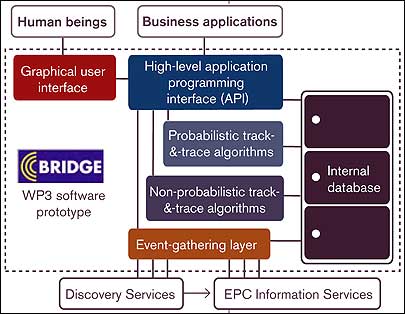Jun 18, 2008By Mark Harrison
When networked RFID systems such as the EPCglobal network are fully deployed, organizations will be able to gather detailed information about the location and status of their products tagged with unique IDs. They will also be able to share some information about these products with partners through information services such as Electronic Product Code Information Services (EPCIS). And they could make some of the information available to others through Discovery Services, restricted search engines that can be accessed by authorized users.
The next challenge is to provide a way to enable organizations to make good use of supply-chain and life-cycle information to help them manage daily operations. At the Cambridge Auto-ID Lab, we are developing an enhanced track-and-trace system as part of the EU BRIDGE (Building Radio Frequency Identification Solutions for the Global Environment) project, a joint venture with 30 partners from 12 countries.
First, we gathered event data from across the supply chain or product life cycle, making queries to multiple EPCIS and Discovery Services. This could involve iterative queries when changes occur—for example, when a case is loaded into a container or bulk products are broken down into smaller units.
Next, we applied hidden Markov models to learn the flow patterns by analyzing the historical data. This helps to filter the data and handle some of the problems arising from imperfections of the automated data-capture technology, such as false positives and negatives. It also allows us to learn the probabilities associated with the paths an object will follow, as well as the statistics about the time taken between two different locations and the time spent at a particular location. And it allows us to predict where objects will appear next and answer probabilistic queries, such as "What is the confidence level that my object will reach location X by time T?"
The Cambridge Auto-ID Lab is collaborating with BT Research and SAP Research to develop a software prototype of the enhanced track-and-trace system. It consists of an event-gathering module, probabilistic and non-probabilistic track-and-trace algorithms, and a graphical user interface (for building a map of a supply-chain network and displaying the results and any alerts about problems). This team will develop an application programming interface (API) to allow users to specify high-level business rules and alerting criteria. The API will also choreograph the calls to the event-gathering module and the probabilistic and non-probabilistic algorithms.
We plan to test the software prototype with real event data gathered from the BRIDGE pharmaceutical traceability pilot. Later in the year, other BRIDGE members will be able to use the software for their pilots and trials.
Mark Harrison, director of the Cambridge Auto-ID Lab, is currently working on further development and standardization activities for Discovery Services.


